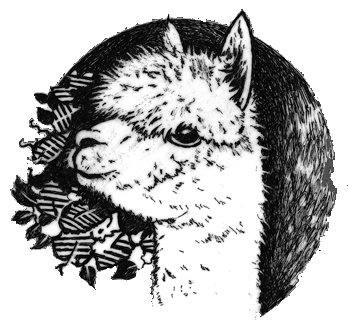.jpg)
.jpg)
 av remsa010 (600 x 205).jpg)


The origin of alpacas
 av remsa010 (600 x 205).jpg)
.jpg)
.jpg)




According to both the Aimara and Quechua-speaking peoples of Bolivia and Peru, long ago the world was made up of two, superimposed worlds, the upper and the lower. The lower world was populated with enormous flocks of plump, sleek alpacas that belonged to the apu, or mountain god, and were tended to by his daughter: The alpacas of the upper world, by contrast, were far fewer in number and were inferior in quality; with only a short fleece.
Because the apuís daughter had difficulty in protecting her alpacas from the region's numerous predators, her father arranged for her to marry a young herdsman from the upper world who could help her tend the flocks. For a while, the apu's daughter and her husband lived contentedly in the inner world. Later; however; the young shepherd grew homesick and told his wife that he wished to return to his own world, and to enrich it with the inner world's flocks. The mountain god's daughter agreed and, collecting her alpacas, began traveling via the springs and lakes to live with her husband in the upper world. Her father's only condition to his daughter's marriage was that her husband take good care of the flocks, and especially of a tiny alpaca that always had to be carried. The daughter's husband proved to be lazy; however; and one day dropped the tiny alpaca on the ground, leaving it to fend for itself. When his wife saw this she took fright and immediately ran to the nearest spring, where she dove in and began swimming towards the inner world. The alpacas followed her; although a few were prevented from doing so by the herdsman. Ever since then, the alpacas of the upper world have remained near springs and lakes. There, they continue to yearn after their mistress who as yet has never returned.
Because the apuís daughter had difficulty in protecting her alpacas from the region's numerous predators, her father arranged for her to marry a young herdsman from the upper world who could help her tend the flocks. For a while, the apu's daughter and her husband lived contentedly in the inner world. Later; however; the young shepherd grew homesick and told his wife that he wished to return to his own world, and to enrich it with the inner world's flocks. The mountain god's daughter agreed and, collecting her alpacas, began traveling via the springs and lakes to live with her husband in the upper world. Her father's only condition to his daughter's marriage was that her husband take good care of the flocks, and especially of a tiny alpaca that always had to be carried. The daughter's husband proved to be lazy; however; and one day dropped the tiny alpaca on the ground, leaving it to fend for itself. When his wife saw this she took fright and immediately ran to the nearest spring, where she dove in and began swimming towards the inner world. The alpacas followed her; although a few were prevented from doing so by the herdsman. Ever since then, the alpacas of the upper world have remained near springs and lakes. There, they continue to yearn after their mistress who as yet has never returned.
The original of the myth is at the Pacomarca website. Will open in new window.
